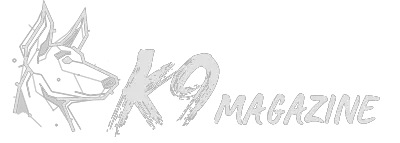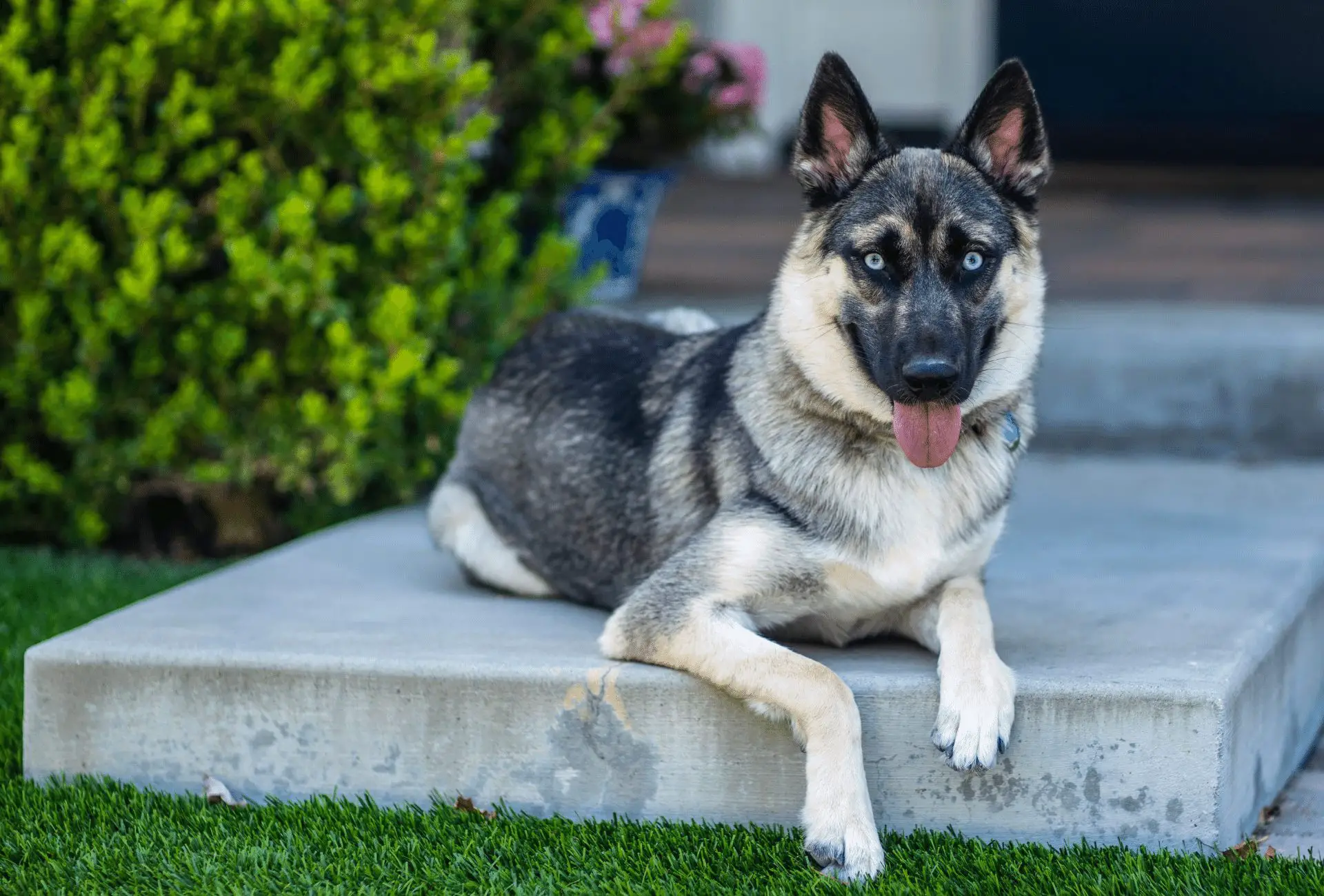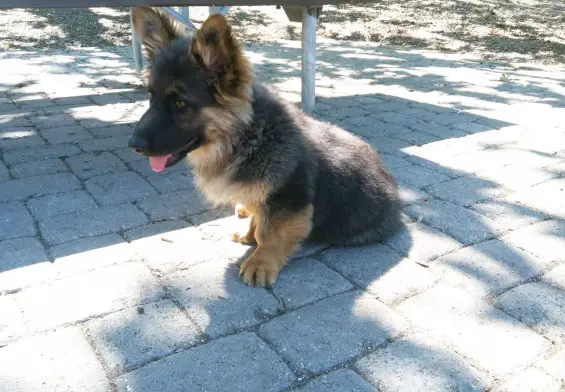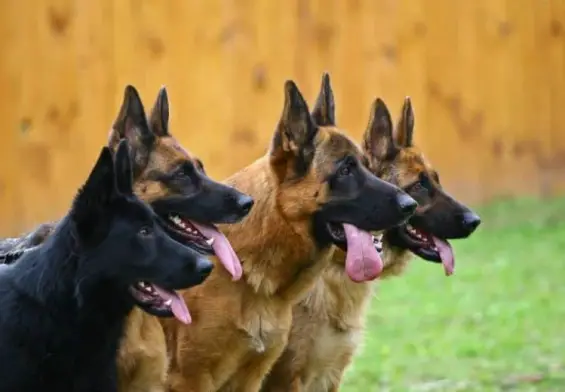Husky German Shepherd Hybrid Mix Dog Breed Guide (Shepsky)
Individually, the German Shepherd and the Siberian Husky are considered excellent working dogs. People who are interested in a large dog go for either of these two breeds often. They are loving and give good company.
What if you could get both of these breeds in one dog? A cross of a German Shepherd and a Siberian Husky would inherit the qualities that make their parents great dogs. They would also balance out any extreme characteristics either of the parents have.
A lovely coin name for the mix is a Gerberian Shepsky. It is not easily pronounceable, so the most common name is Shepsky. The mix has existed for a very long time and had gone unnoticed until crossbreeds became popular.
The German Shepherd can be bred with most other dog breeds to get German Shepherd mixes like the Shepadoodle and Sheprador. A cross of a Shepherd and a Husky results in a massive dog like its parents.
They are bold and smart enough to complete tasks on their own and act out commands. They are also powerful dogs mostly and can lend a hand in doing work around the home. They have a wolf-like appearance that they inherit from the Husky.
Origins of the Shepsky
A mix of a Shepherd and a Siberian Husky is naturally an alpha dog. Both parents are bold and fierce dogs that are loyal to a fault. They learn commands quickly and are therefore easy to train. They have the capacity to learn and execute specialized commands.
The origin of the Shepsky can be understood better once we take a look at their parents. Both breeds are different yet come together to have a puppy with an adorable personality and a fierce demeanor when required.
German Shepherd
German Shepherds originated in the eighteenth century from the first German Shepherd called Horand von Grafrath. All other Shepherds’ lineages can be traced back to the first German Shepherd.
A captain in the German army had a dream of an ideal dog and created the German Shepherd breed. He owned the first dog, and early in the nineteenth century, the breed was recognized by the American Kennel Club.
Siberian Husky
They originate from North-East Siberia, where the Chukchi reside. They bred them mainly for the company and as sled-pulling dogs. They can thrive in cold areas because of their coat and other characteristics.
They became famous when they won a sled race of six hundred and fifty-nine miles in five days in the 1900s. In the relay, the lead canine was called Balto and is now the most honored canine after running to Nome and getting medicine in 1925.
Huskies are twelfth in popularity in the world.
Physical Characteristics of the Shepsky
All dog breeds pass down their physical attributes to their young ones. The same goes for the Husky-Shepherd mix. They inherit the characteristics from each of their parents and blend them.
However, the characteristics are not passed down in the same way, resulting in dogs with varying degrees of inherited features. This way, no dog is the same even though they have parents of similar breeds.
However, puppies born in a litter will have closely similar features. They will still differ from other litters. The differences are not stark, and therefore some relation can be seen between the dogs. Their similarities outweigh their differences.
Some Shepskies will be leaning more towards the German Shepherd. Others will lean more towards the Husky, and some will inherit almost the same characteristics from each parent. They are all lovely puppies, regardless.
The physical attributes passed down include:
Facial Appearance
A Shepsky resembles a wolf. They have pointed ears that make them look like they are always alert. They can have blue eyes, or in some rare cases, they could inherit both color eyes from each parent like in the Husky.
Lifespan
Usually, the Shepsky lives to be about ten or thirteen years old, and in some cases, they live up to eighteen years old. They are a great dog to have as a companion because they will live for a long time. Their lifespan depends on many factors.
Genetics, environmental challenges, food, and health status contribute to the lifespan of the Shepsky. They will live for longer if they are well cared for, starting from a good diet, regular health checkups, exercise, and right living conditions.
Size and Weight
When they are fully grown, Siberian Huskies grow to a height of about twenty-three inches at most and weigh from thirty-five to sixty pounds. They fall in the category of medium size dogs. German Shepherds grow to about twenty-six inches tall and weigh up to ninety pounds.
A cross between the two would inherit an average of their sizes. A Shepsky will most likely also fall in the category of medium-sized dogs and weigh about the same as their parents once fully grown.
Coat
Both breeds have thick double coats. However, the hairs can be longer in the Siberian Huskies than in German Shepherds. Their offspring inherits a thick double coat and can either have long or short hairs in varying densities.
Colors
Many crossbreeds have darker colors because the dark shades dominate over the light ones. They mostly appear dark because of this. However, some light-colored dogs are born from parents with dominating lighter shades on their coats.
The colors may be pure or a mixture of blue, black, cream, gray, brown, white or golden. In some instances, the colors may be lighter, but those are rare. In reality, many mixes acquire darker-toned colors.
Behavioral Characteristics
The Gerberian Shepsky has a stature that portrays boldness and fierceness. However, it is gentle and calmer than it looks. They are great pets because of their composure and their playful side. I will list some of their behavioral traits below.
- They are active and playful.
Typically, they are full of energy and therefore need regular exercise to use up some pent-up energy. If they do not get adequate training, the pent up energy could make them destructive to the property as they seek something to play with.
Due to the amount of energy they have, they need long walks and at least one hour of playtime every day. They can also be taken to the backyard and left to run around. However, the yard has to be fenced off for their safety and the safety of anyone else.
- They are keen and protective.
They usually are excellent guard dogs. They note changes in their environment quickly and alert their companions of any impending danger. They are always alert, and their large ears allow them to hear things from far.
However, they can excessively bark because they want to alert their companions of every change they note. It can be hard to identify whether the dangers are real because of constant barking. The good thing is that you can always be sure they will protect you.
- They are sweet and friendly.
They show their feelings openly towards people. They also love being petted. You also need not worry about them getting aggressive with other animals in the home. They mingle well with other pets and people if they are socialized well.
- They are loyal.
Many dog handlers and companions seek out loyal dogs because they can be counted on even when there is danger. They will stick by you and protect you with all their might. They also protect your property with their lives.
- They are smart.
An intelligent dog breed like this can learn more commands and execute them better and faster each time. They also can understand complex commands and are suitable for specialized tasks like search and rescue and nose work.
Trainers have an easy time teaching them because they learn fast and have a desire to learn more. They also do not shy away from difficult tasks because of their focus when carrying out commands.
Health and Wellbeing
Crossbreeds have genetic differences that make it difficult to predict health complications. In some instances, crossbreeding eliminates some health complications that may occur in purebred pups.
However, some confirmed health conditions are common in the German Shepherd-Husky mix. We will discuss some of them and the measures that can be taken to either prevent or slow each one’s progression.
Hip and Elbow Dysplasia.
Dysplasia is a condition that causes the loosening of the joints of the elbow and the hip. In most cases, it is preceded by obesity and lack of adequate exercise. Exercising your dog keeps it in shape and allows its body to burn off excess fat that may lead to obesity.
The unstable joints will significantly affect the movement and activity of the dog. They will need breaks often because of joint pain. The pain can also be too much to handle in severe cases. In the end, they will be unable to support their weight and hinder their mobility.
The best way to fight the condition is to make sure the dog gets regular exercise. The playtime should also be of the required amount of time. Regulating your dogs’ diet also helps them only eat high-quality food in the right amount at the recommended times.
Eye Infections
Several eye conditions may manifest in the Shepsky. Most of them are treatable, and others are easily preventable. A proper diet could be the difference between a healthy dog and an unhealthy dog in every health condition.
They include:
Canine glaucoma
Canine glaucoma attacks the optic nerve in dogs. They cause pressure in the eyes, and the dog will have trouble seeing through that eye. About forty percent of affected dogs end up blind in the affected eyes.
Corneal dystrophy
This disease causes abnormal materials to accumulate in the eye, especially at the cornea. This disease may progress to a point where the dog loses vision. Regular checkups will catch the symptoms early, and the right course of action can be taken.
Juvenile Cataracts
It is known to occur when the dogs are little puppies. They may begin to show by the fifth month, and without proper treatment, it progresses so fast that they end up blind within a year. Checkups at the vet should be done very early so that you do not get caught off-guard.
Progressive retinal atrophy
The disease is hereditary, and you can get information on whether either parent had the disease to prepare yourself better to handle it. It manifests when the dog is old, so you will not need to worry for some time.
It is common among old dogs. It is characterized by dilated pupils, light sensitivity, and night blindness. The condition may be incurable, but the progression can be delayed if it is detected early, thus saving your dog’s vision.
Epilepsy
Epilepsy also occurs in dogs. It is a neurological disorder in dogs that causes recurring seizures. Sometimes the affected dogs may lose consciousness. Some medicines offer relief and help manage the condition.
Cancer
Cancer causes abnormal growth of cells that may spread to other parts of the body. Some cancers can be managed, but others are difficult to treat. Dogs suffering from cancer are more common than people think. The German Shepherd and Husky breeds are prone to cancer.
Ear Infection
Dogs with large ears have a higher tendency to contract ear infections. The Shepsky has large upright ears that may get infected easily. They need to be cleaned to remove wax and dirt. They also need to be inspected by a veterinarian once in a while.
It is best practice to use recommended ear cleaning products that are safe for dogs. The right products are soft so as not to damage the delicate parts of your dog’s ears.
Care and Maintenance
Your dog needs your constant care. They need to be groomed and cleaned. They need exercise, and you need to be present to supervise them. You also need to have regular appointments at the pet clinic for checkups.
Grooming
The mix is a moderate shedder, so they will not cover your entire living space with dog hair. However, they may not be great for people with allergies. There are other hypoallergenic dogs to choose from if anyone in the family has allergies.
They have thick coats that need regular brushing. Two times a week, brushing will help maintain their coat and remove any excess fur that has been shed. They shed more when the seasons are changing, so you may need to increase the number of times you brush.
One thing to note is that a Shepsky should never be shaved. It may cause skin infection that is common after shaving double-coated dogs. The coat also serves a purpose for the protection of the dog. Shaving it leaves them defenseless against the cold.
Exercise and Training
All dogs need exercise to keep them in shape and healthy. Teaching dogs at an early age helps them grow up well-adjusted around humans, other animals, and with children. The same goes for a Shepherd-Husky mix.
Socializing them at an early age will eliminate shyness around humans and reduce their chances of becoming aggressive. They are intelligent and can learn quickly. If they have the right training, they are going to learn and do a lot more.
For their training to be successful, it has to be consistent. A schedule may help keep the training regular and adequately timed. It also has to be engaging. That way, they can be comfortable and have fun.
Being strict with them can curb their playfulness and make them focus on the training. After a while, the practice should be refreshed to reinforce it in their minds. However, with the Shepsky being very smart, there will not be a need to repeat their training continually.
The exercise should be enough. The mix does not get tired quickly, even after rounds of high-intensity training. However, remember to provide them with enough food and water not to get dehydrated and hungry.
Feeding
These are giant dogs and should get enough food that is high in nutrients. Proper nutrition will result in healthy growth and a robust immune system to fight off infections. Lack of adequate food could hamper their growth and health.
The proper meal should be high in nutrients and vitamins. They should also get clean water to drink all through the day to minimize the risk of dehydration.
Living Condition
A German Shepherd Husky mix is a large dog and will require enough room to run around. They are also very active, so the place they stay should be large and fenced off to keep them from wandering.
If you have an active family, take the dog with you on some of the activities. If you are too busy to have regular walks make sure they have adequate room to roam freely and exercise. You may play games with them to stimulate their minds.
They are perfect in a moderately cold climate because they have a double coat. Hot and humid conditions would be very uncomfortable for your dog.
Price
The mix can go from between three hundred and fifty to nine hundred dollars. Their medical care is also expensive ranging from five hundred to six hundred dollars a year. Other costs incurred for training, games, and grooming could add up to over a thousand dollars per year.
Before getting this mix, you need to afford the expenses easily. Otherwise, you may not be able to provide the best care for them. Being unable to care for your dog because of the running costs could significantly affect the dog’s wellbeing.
More Information
People looking to add dogs to their family usually consider whether they can interact well with children. The ideal way of introducing a Shepsky to your family is by getting a puppy. A puppy is easy to train and will get used to the family members from an early stage.
Shepskies are gentle giants and will fit nicely within a family setup. Usually, people regard large dogs as menacing and scary, but their reactions may change once they meet the Shepsky. They are delightful with humans and enjoy the company of children.
They can be protective when the need arises. They can look out for children as they play outside and can stand guard at your home or watching out for any intruders. They should begin training at a young age so that they are not shy around people by the time they are grown.
After they have learned all the primary commands, you may want to consider hiring a professional trainer to teach them more specialized skills. These skills give them a purpose and a goal in life that they are more than willing to execute.
It also does not hurt to have your dog learn how to conduct a search and rescue mission. It may become their way of contributing to the society around you. They are very alert and can detect movement from far, so they can also help track.
The German Shepherd Husky is not for everyone. They require a commitment to their exercise, their diet, their health, and companionship. If you are not ready for all of that or are unable to fulfill these duties, you should not get one.
Other people who should not consider getting a Shepsky are people allergic to dogs. They shed their hair, and even though it is not a lot, it may be harmful to their health. In this case, there are other hypoallergenic dogs available.
Other than that, Shepsky fits the lifestyle of most people. Provided that they are adequately exercised and have regular screenings at the vet, they will be okay. They should also have access to high-quality food and clean drinking water.
After considering all the pros and cons of getting a Shepsky and deciding to get one, there are two ways of doing that. You may buy a puppy from a fully licensed breeder, or you may adopt a rescue dog.
If you are getting a puppy from a breeder, they have to be licensed and operate in an environment conducive to dogs. Many puppy mills disregard the health and wellbeing of the dogs and should be shut down.
A breeder will often have more information about the parents of the puppy you are getting, which can help prepare you to take care of the dog. You will have enough information to predict the health of your dog.
The other option is in adopting a dog. Adopting is noble because all dogs deserve a right home where they are cared for and loved. Adult Shepskies are found in shelters. However, their history may be vague.
It is a bit difficult to care for them because they may not have received the proper training. Their health may be of concern, so it is advisable to go to a vet for a full medical workup. It will provide you with the necessary medical information to be able to care for them.
Nonetheless, they are as loving as homegrown puppies. They will need the same amount of care. Seeing as they are already developed, it is recommended that you refresh their training and get them a regular training schedule.
Conclusion
A German Shepherd and a Siberian Husky are fundamentally different. However, they share some common traits and have outstanding individual characteristics. The German Shepherd is a favorite worldwide, and the Siberian Husky is irresistible mostly because of its fluffy fur.
However, crossbreeding is not guaranteed to result in a dog with balanced traits. Some will lean to either side. Owners of these dogs will have to pay attention to the health risks that the mixes face.
They need constant care for their hygiene, their health, and their food consumption. To grow healthy and strong, they should get proper exercise for the required amounts of time. Companions should also have an excellent diet plan that is full of nutrients.
The health conditions they are prone to may manifest at any point, so they should get regular visits to the veterinary clinic to be safe. Many of the incurable health issues are still manageable, and owners should familiarize themselves with the care they ought to give.
There are a lot of Shepskies in shelters who need a home. Adopting dogs is not ideal for many people, but it is a noble act that saves dogs from sub-par living and gives them hope. Shepskies are loveable and would fit well in your home.
They are easy to train and love to learn, and that makes them the perfect service dog. They can learn specialized commands and skills to offer unique services like sniffing out contraband or performing search and rescue.
They may be easily trainable, but they can take on a playful side. It would be best if you then were firm with them to make them focus. Their fun side is great for family events and outings when playing with children, but they may be distracted sometimes in training.
You should please consider having one of these gentle giants as an addition to your family.





